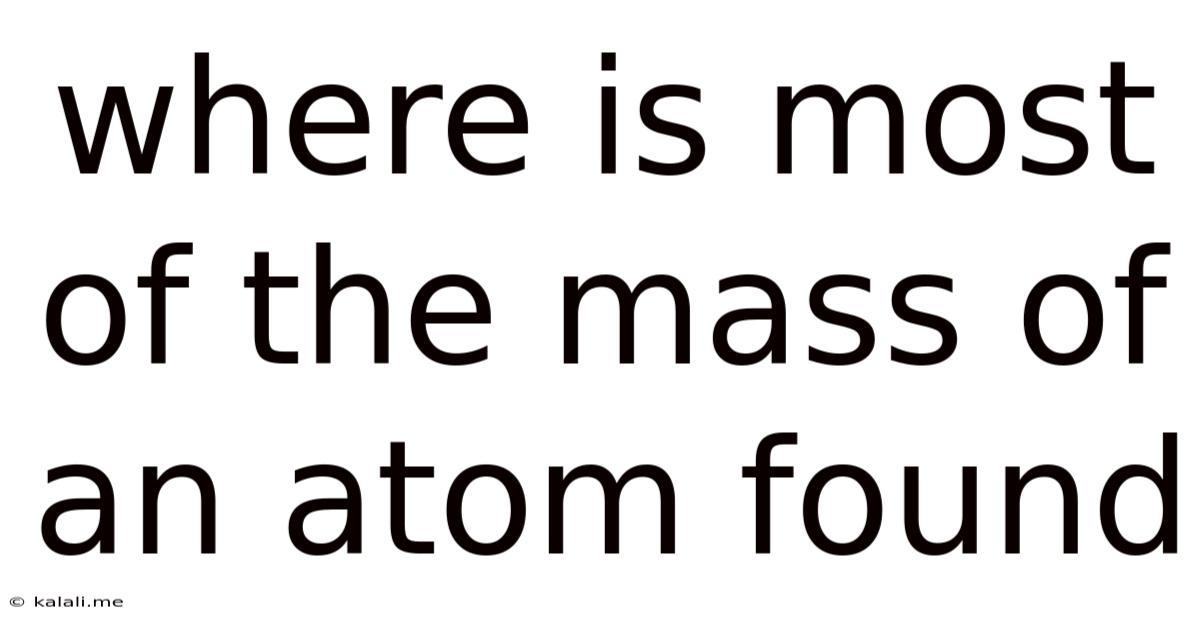Where Is Most Of The Mass Of An Atom Found
Kalali
Jun 11, 2025 · 3 min read

Table of Contents
Where is Most of the Mass of an Atom Found? A Deep Dive into Atomic Structure
The seemingly simple question, "Where is most of the mass of an atom found?" leads us on a fascinating journey into the heart of matter. Understanding this requires a basic grasp of atomic structure and the relative contributions of its components. This article will explore this fundamental concept in physics, explaining why the answer isn't as straightforward as it might initially seem.
Most of an atom's mass is concentrated in its nucleus. This tiny, dense region at the atom's center houses two types of subatomic particles: protons and neutrons. Electrons, the other major component of atoms, contribute minimally to the overall mass.
The Nucleus: A Dense Core
The nucleus is incredibly small compared to the overall size of the atom. Imagine a football stadium: the nucleus would be the size of a pea at the center, while the electrons would be like tiny gnats buzzing around the entire stadium. Despite its minuscule size, the nucleus contains almost all of the atom's mass because protons and neutrons are significantly more massive than electrons.
- Protons: Positively charged particles that determine an element's atomic number.
- Neutrons: Neutral particles that contribute to an atom's mass but not its charge. The number of neutrons can vary within an element, leading to isotopes.
Electrons: Negligible Mass, Significant Impact
Electrons, negatively charged particles orbiting the nucleus, are far less massive than protons and neutrons. Their mass is so small that it is often considered negligible when calculating the total mass of an atom. While their mass contribution is minimal, electrons play a crucial role in chemical bonding and determining an atom's chemical properties. Their position and movement determine how atoms interact with one another.
Isotopes and Mass Number
The number of protons defines an element, while the sum of protons and neutrons determines the atom's mass number. Different isotopes of the same element have the same number of protons but varying numbers of neutrons. This means different isotopes of the same element have slightly different masses. However, the overwhelming majority of this mass remains concentrated within the nucleus, regardless of the specific isotope.
Practical Implications
Understanding where an atom's mass is located is fundamental to numerous scientific fields. This knowledge underpins our understanding of:
- Nuclear Physics: Nuclear reactions, such as fission and fusion, involve changes in the nucleus and release tremendous amounts of energy.
- Chemistry: The mass of atoms determines the molar mass of substances, which is crucial for stoichiometric calculations and chemical reactions.
- Materials Science: The properties of materials depend on the atomic structure and the interactions between atoms, strongly influenced by the nucleus's mass and the electron arrangement.
In conclusion, while electrons play a vital role in the chemical behavior of atoms, the vast majority – over 99.9% – of an atom's mass resides in its nucleus, specifically within the protons and neutrons. This fundamental fact is crucial for comprehending the behavior of matter at both macroscopic and microscopic levels.
Latest Posts
Latest Posts
-
How Many Times Does 11 Go Into 40
Jul 01, 2025
-
Elvis Presley Gospel One Pair Of Hands
Jul 01, 2025
-
What Is The Fine For Killing A Buzzard
Jul 01, 2025
-
How Old Am I If I Was Born In 1996
Jul 01, 2025
-
What Is 3 X 3 X 3
Jul 01, 2025
Related Post
Thank you for visiting our website which covers about Where Is Most Of The Mass Of An Atom Found . We hope the information provided has been useful to you. Feel free to contact us if you have any questions or need further assistance. See you next time and don't miss to bookmark.